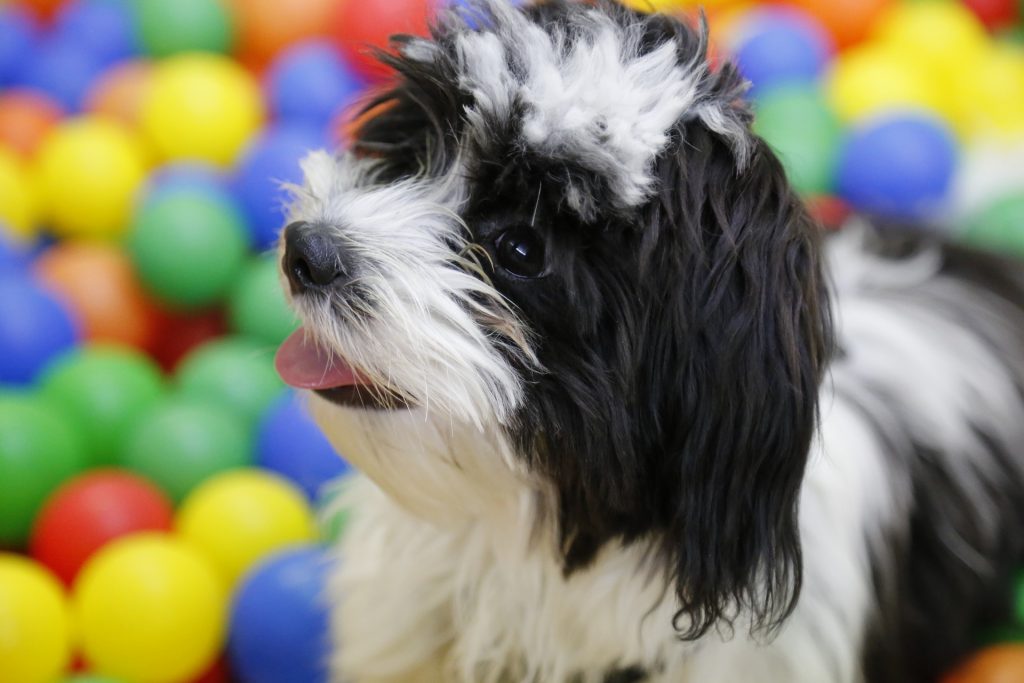Do you own a deaf dog? Have you ever had the opportunity to work with a deaf dog? I had not — until Whitney. As a senior dog, Whitney lost all of her hearing, although her eyesight remained perfectly intact. She could see a robin clear across the yard!
Different strengths, senses, strategies
While Whitney’s deafness was a training challenge and required some modifications, I believe that her other senses (smell, peripheral vision, body language) may actually be enhanced, as often happens when humans are deaf. Although all dogs are acutely aware of body language, deaf dogs are even more keenly observant of body language and gestures. This was certainly true in Whitney’s case.
Owners and trainers “speak” to dogs, teaching them to comprehend intent and meaning. With a deaf dog, the verbal avenue is not an option. Communication needs to focus on the visual sense instead. What is most important is to be careful and deliberate with hand, face, and body movements.
Bridging the communication gap
In Whitney’s case, I would clap my hands when she executed a desired behavior correctly. That training cue was more for me than her. Of course Whitney could not hear my applause, but she recognized bringing my hands together as positive feedback. In teaching Whitney this new cue, I would immediately reward her with a treat, and this communicated that she had earned access to something that she found reinforcing.
With a deaf dog, one of most helpful behaviors, and one to work on first, is to mark and reinforce heavily for eye contact. Obviously your dog must be looking at you to see any hand gestures that you are displaying.
The next step was to watch for something that Whitney did that I liked. For example, when she sat, I would mark that behavior with a visual hand clap marker and then reinforce the behavior. I needed to be quick to catch Whitney looking at me in order to give my visual marker, and then reinforce it.
Attention!
Fostering a “check-in” behavior is essential. Getting a deaf dog’s attention is another consideration, as it is not possible to call out to your pup. Each and every time that your dog looks at you, you should mark and reinforce this behavior. Sometimes you can get your deaf dog’s attention via vibrations. Tapping or stomping on the floor may create a vibration large enough to attract your dog’s attention. I used this technique all the time in the house with Whitney. Once your dog looks at you, mark and reinforce that attention. When I would call Whitney in from the yard I would swing my right arm across my chest, bringing my hand to my left shoulder. This large sweep was easily visible for Whitney to see from a distance.
Another option, if it’s dark or at dusk, is to flick the lights off and on to draw your dog’s focus back to you. Some people use a small flashlight, but remember never to shine the light directly into the dog’s eyes. Remember that every time you mark, you will want to follow up with something that your dog finds reinforcing.
Another helpful behavior to train with a deaf dog is a shoulder tap that means “look at me.” Tap your dog on the shoulder and then pop something yummy (just a tiny piece) in his mouth. Repeat this pattern often, and in every room of your home, and then begin to practice outside as well. Your dog will come to understand that the tap equals good things for him, and he will begin to turn back to you, anticipating the yummy treat.
Continue to practice and “pay” for your dog turning to look at you. Eventually, after many, many, many repetitions, you may be able to replace your food reinforcer with attention and affection in order to keep the behavior strong once it has been established.
When you start to train the shoulder tap, be mindful that deaf dogs often startle. As a deaf dog cannot hear an approach, and sometimes cannot feel vibrations of someone nearby, the dog may startle when you appear suddenly. Work on associating people’s approach with positive things. You may have to hold a tiny bit of a yummy food each time you get near your deaf dog.
Visual signals
The next step in training a deaf dog is to build more visual cues for communication. Some people choose to use American Sign Language (ASL) signs and/or single-hand adaptations of the ASL signs. You can also make up your own signals as long as they are distinct and consistent.
The importance of recall
Another vital part of communicating with a deaf dog is teaching a recall. I always advocate in favor of safety first, so I recommend working on longer-distance recalls in fenced areas or with a long leash. However, as with any behavior, you will want to start training in close proximity and in a low-distraction environment. Move away, at first just an inch at a time, and then signal with a visual cue for your dog to come to you. Mark movement toward you and be sure to reinforce as the pup arrives where you are. As with any recall, slowly build distance and eventually build in distractions.
The regular “check-in” behavior that you trained earlier will be important now as you work on recall with a deaf dog. You need your deaf dog to look back at you for instruction. Behaviors that are reinforced are repeated, so be sure that your pup finds coming to you when “called” a highly reinforcing behavior! Remember, just like training a hearing dog, be sure to break any new behavior into small pieces and train in short training sessions with many opportunities to “get it right.” Always end the exercise on a positive note.
Expect, and handle, frustration
There are common frustrations training ANY dog, or ANY animal. However, with a deaf dog, these feelings of exasperation may be intensified. Try to remember that even if you believe you have broken down the task into very small, manageable pieces and are communicating very clearly and efficiently, you are, in fact, communicating with a different species.
Because humans are verbally oriented in our information exchanges, communicating in different ways with a deaf dog may be a struggle at first. Any time that you feel overwhelmed, stop and take a break. Revert back to something very simple, like making eye contact and marking and reinforcing this successful behavior. Celebrate tiny accomplishments; remember that this is a marathon and not a sprint. Your communication and training with your deaf dog, as with hearing dogs, will be a lifelong endeavor.
Dog bless.
Resource: Terrie Hayward/clickertraining.com

Judy Endo is the author of Paws-itive Pet Tales. A lifelong resident of the Wilkes-Barre area, she has been a professional dog trainer/competitor as well as a lifetime animal lover and strong supporter of animal rescue. Contact: judyendo@outlook.com




